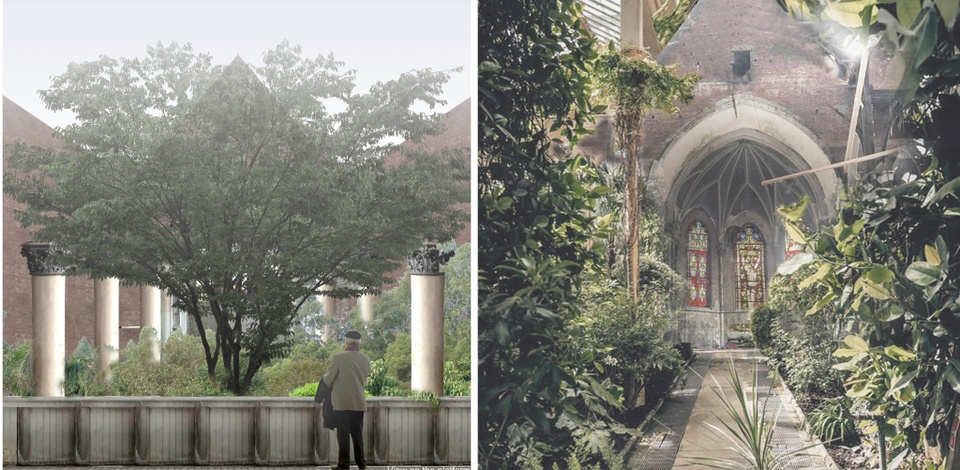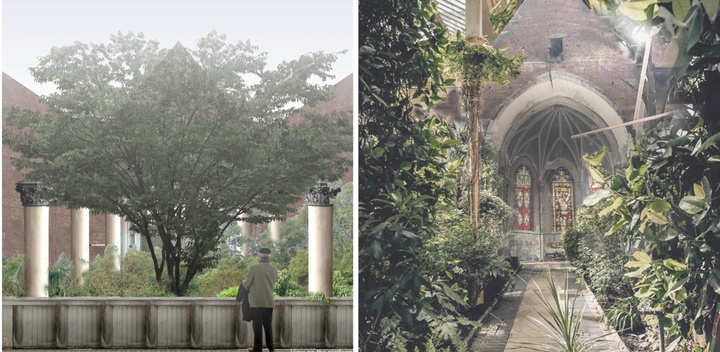Vacant/Wild/Ruined: Feral Urbanism
2020-05-07 • Liz Kramer

Students on a walking tour of Old North St. Louis with resident Matt Fernandez.
Spring 2020 architecture seminar led by senior lecturer Michael Allen
Urban design, architecture, and landscape architecture may focus on the growth of cities, yet a decline in population or stagnation of growth creates new opportunities for design, policy, and reevaluating the relationship to land. The dynamics of a city like St. Louis require designers to be able to address conditions such as continued decline, vacancy, and re-wilding. In this seminar, students explored experimental urban land management and preservation practices such as land banking, land trusts, managed depletion, wilderness conservation, agricultural land reclamation, homesteading, demolition, and more. These tactics raise important questions about economic systems, including political austerity and the rights of residents to the land and its future.
These topics are particularly relevant in the City of St. Louis, characterized as America’s fastest-shrinking city from 2014-2019. Specifically, the Old North St. Louis neighborhood represents a case study in this decline. Having lost over 60% of its peak population since 1950, the neighborhood has continued to thrive through the creativity and investment of residents. The students immersed themselves in the neighborhood to better understand the ongoing efforts to create a sustainable, just, and vibrant future.
Senior lecturer Michael Allen, a former resident of Old North St. Louis who has been engaged in past building preservation and activism for the neighborhood, developed a partnership with the Old North St. Louis Restoration Group (ONSLRG), an all-volunteer, community-based nonprofit dedicated to the revitalization of the physical and social dimensions of the community. ONSLRG was able to pinpoint areas where students could support ongoing work to develop tools for identifying, assessing, and repurposing vacant lots and buildings in the neighborhood.
Students worked with ONSLRG to identify vacant buildings and lots where their speculative proposals could help galvanize attention to pressing conditions. Special attention was given to buildings facing likely demolition that are valuable to the community, lots adjacent to recent revitalization projects, and properties owned by speculators whose ownership has impeded community planning goals. Students also engaged Project Augustine in the adjacent St. Louis Place neighborhood, where a team recently began trying to stabilize and eventually rehabilitate an abandoned Gothic Revival church built in 1896. For buildings identified by both organizations, students devised speculative plans for reuse based on community needs and site conditions and created boards for exhibition and publication.
In addition to the students’ work, the course spent the first half of the semester meeting in Old North St. Louis. Funds from a CityStudioSTL Faculty Grant helped support renting space at Central Print, a studio and classroom space focused on promoting the art of letterpress. The funds also supported an Old North resident who provided two extensive guided tours of the neighborhood, discussed the techniques of rehabilitating abandoned buildings, and provided feedback to student work. The course moved to a virtual format about halfway through the semester due to the COVID-19 pandemic. A planned exhibition has been postponed, but the student work and course themes will become the subject of a public video funded by the grant.
Partners
Old North St. Louis Restoration Group
Central Print
Vacancy Collaborative
Support From
- CityStudioSTL Faculty Course Grant









